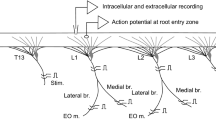Summary
This paper describes the electrical activity recorded extracellularly from the axons innervating the ventral abdominal intersegmental muscles ofRhodnius prolixus. These muscles go through a cycle of growth and degeneration in each larval stage, and the axons innervating the muscles have been shown previously to make neuromuscular contact with the muscles and also to be neurosecretory.
-
1.
Spontaneously occurring centrally generated action potentials travel along the motor nerve to the muscles both when the muscles are fully developed and when they are degenerate.
-
2.
Spontaneously occurring peripherally generated action potentials travel along the motor nerve to the central nervous system when the muscles are degenerate.
-
3.
Irregular, regular and bursting patterns of centrally generated activity occur.
-
4.
It is suggested that the peripherally generated action potentials are being conducted antidromically along the motor nerve.
Similar content being viewed by others
References
Anwyl, R., Finlayson, L. R.: The ultrastructure of neurons with both a motor and neurosecretory function in the insectRhodnius prolixus. Z. Zellforsch.146, 367–274 (1973)
Atwood, H. L., Luff, A. R., Morin, W. A., Sherman, R. G.: Dense-cored vesicles at neuromuscular synapses of arthropods and vertebrates. Experientia (Basel)27, 816–817 (1971)
Bennett, M. V. L., Fox, S.: Eleotrophysiology of caudal neurosecretory cells in the skate and fluke. Gen. comp. Endocr.2, 77–95 (1962)
Berlind, A., Cooke, I. M.: The role of divalent cations in electrically elicited release of a neurohormone from crab pericardial organs. Gen. comp. Endocr.17, 60–72 (1971)
Bern, H. A., Yagi, K.: Electrophysiology of neurosecretory systems. Proc. II. Intl. Cong. Endocrinol. Exc. Medico Intl. Cony.83, (Part 1), 577–583 (1965)
Cooke, D. J., Millegan, J. V.: Electrophysiology and histology of the medial neurosecretory cells in adult male cockroaches. I. Insect Physiol.18, 1197–1124 (1972)
Cooke, I. M.: Electrical activity and release of neurosecretory material in crab pericardial organs. Comp. Biochem. Physiol.13, 353–366 (1964)
Douglas, W. W., Poisner, A.: Stimulus secretion coupling in a neurosecretory organ; the role of calcium in the release of vasopressin from the neurohypophysis. J. Physiol. (Lond.)172, 1–18 (1964)
Finlayson, L. H.: A comparative study of the effects of denervation of the abdominal muscles of saturniid moths during pupation. J. Insect Physiol.5, 108–119 (1960)
Finlayson, L. H., Osborne, M. P.: Electrical activity of neurohaemal tissues in the stick insectGarawsius morosus. J. Insect Physiol.16, 791–800 (1970)
Finlayson, L. H., Osborne, M. P.: Secretory activity of neurons and related electrical activity. Adv. comp. Biochem. Physiol. (in press)
Frazier, W. T., Kandel, E. R., Kupferman, I., Waziri, F., Goggleshall, R. E.: Morphological and functional properties of identified neurons in the abdominal ganglia ofAplysia californica. J. Neurophysiol.30, 1248–1351 (1967)
Lockshin, R. A., Williams, C. M.: Programmed cell death. III. Neural control of the breakdown of the intersegmental muscles of silkmoths. J. Insect Physiol.11, 601–610 (1965)
Maddrell, S. H. P.: Nervous control of the mechanical properties of the abdominal wall at feeding inRhodnius. J. exp. Biol.44, 59–68 (1966)
Neusch, H.: The role of the nervous system in insect morphogenesis and regeneration. Ann. Rev. Ent.13, 27–44 (1968)
Osborne, M. P., Finlayson, L. H., Rice, M. J.: Neurosecretory endings associated with striated muscle in three insects (Schistocerca, Garausius andPhormia) and a frog (Rana). Z. Zellforsch.116, 391–404 (1971)
Runion, H. I., Pipa, R. L.: Electrophysiological and endocrinological correlates during the metamorphic degeneration of a muscle fibre inGalleria mellonella (Lepidoptera). J. exp. Biol.53, 9–24 (1970)
Yagi, K., Azumo, T., Matsude, K.: Neurosecretory cell: capable of conducting impulses in rats. Science154, 778–779 (1966)
Author information
Authors and Affiliations
Additional information
We are grateful to the Science Research Council for financial assistance.
Rights and permissions
About this article
Cite this article
Anwyl, R., Finlayson, L.H. Peripherally and centrally generated action potentials in neurons with both a motor and a neurosecretory function in the insectRhodnius prolixus . J. Comp. Physiol. 91, 135–145 (1974). https://doi.org/10.1007/BF00694269
Received:
Issue Date:
DOI: https://doi.org/10.1007/BF00694269




